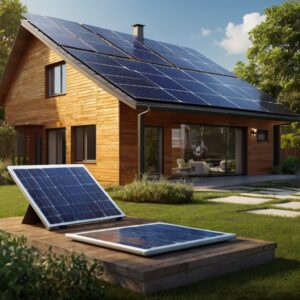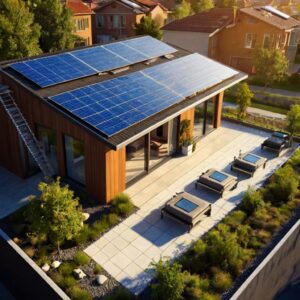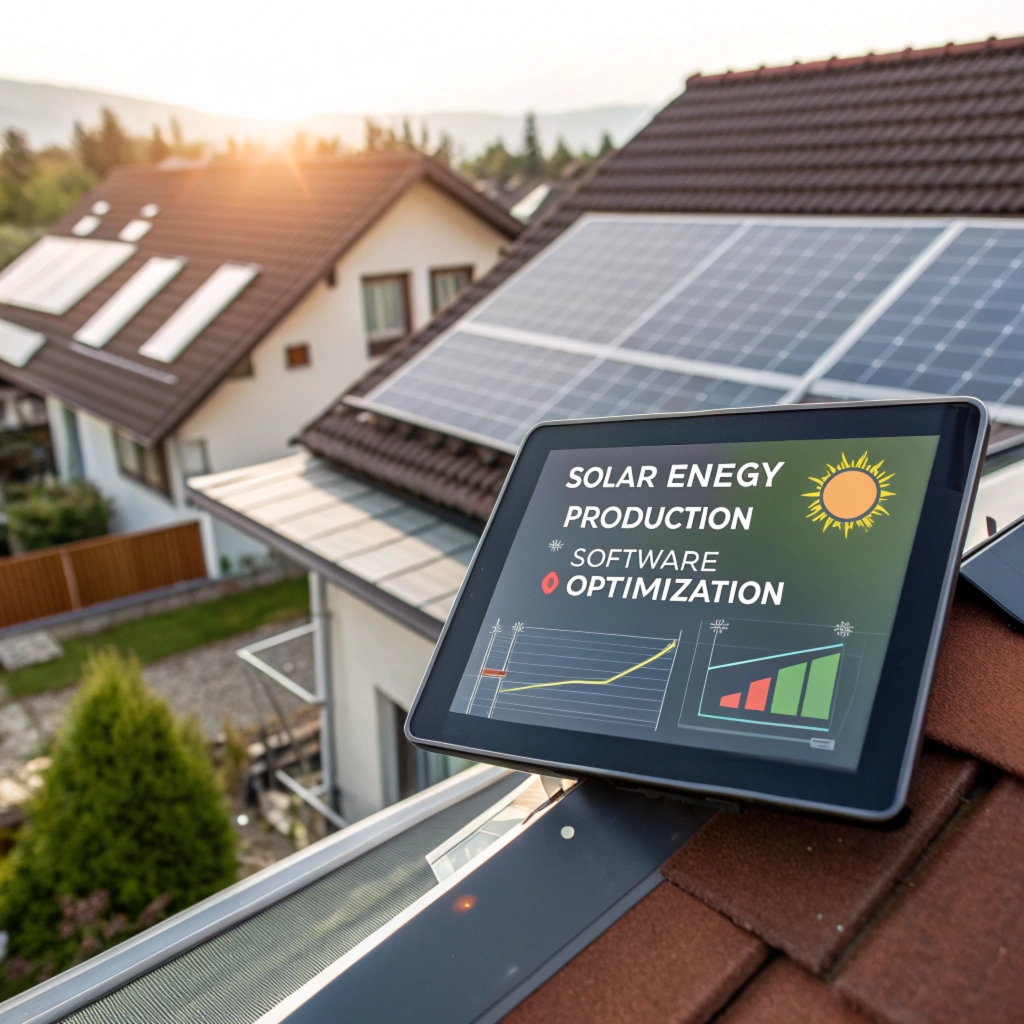
Are you tired of feeling like your home is wasting potential, leaving you to wonder what could have been?
You’re not alone. Many homeowners and businesses are stuck in a cycle of inefficiency, throwing money away on unnecessary upgrades or maintenance.
But with the right tools, anyone can unlock their home’s true potential – maximizing energy savings while ensuring peak performance.
With our cutting-edge software, you’ll be able to:
- Analyze your solar panel system like never before
- Optimize its performance for maximum efficiency and revenue
- Stay on top of maintenance needs with personalized alerts
Say goodbye to wasted energy and hello to a more sustainable future. Discover how our innovative tool is helping homeowners worldwide streamline their systems, maximize returns, and join the sustainability revolution!
Understanding Your Home’s Unique Solar Potential
Getting into optimizing your home’s potential for solar power, it becomes clear that understanding its unique capabilities is key. A thorough assessment of your property’s size, shape and orientation plays a significant role in determining how much sunlight it receives throughout the day.
The amount of direct sunlight hitting your roof at different times can vary greatly depending on factors like latitude and local climate conditions. To maximize energy production, you’ll want to position solar panels to capture these sunbeams most effectively. This may involve strategically placing them across different aspects of the property – either east-west or even a north-south orientation for better exposure.
A closer examination into your neighborhood’s unique sunlight patterns can be achieved by studying charts and graphs that illustrate local climate conditions, taking note of shading from trees or buildings, and other environmental factors. This will allow you to position solar panels in such a way that they are able to get maximum exposure throughout the day.
How AI-Driven Panel Optimization Can Save You Money
Maximizing Your Home’s Potential: Boosting Energy Efficiency with AI-Driven Solar Panel Optimization Software
Think of your solar panel system like a high-performance athlete. With the right training – in this case, AI-driven optimization software – it can perform at peak levels, maximizing efficiency and reducing waste.
AI-driven solar panel optimization software uses machine learning algorithms to analyze real-time data on weather patterns, energy usage, and seasonal changes. This allows for precise adjustments to be made in the system’s operation, resulting in increased efficiency and reduced waste.
For instance, if you’re looking at reducing your carbon footprint further or want to sell excess energy back into the grid, these software systems can help achieve this goal through advanced analytics that provide detailed insights on usage patterns. Homeowners have reported an average reduction of $500 per year in electricity bills, while also decreasing their carbon footprint by 20%. This results from a more efficient system that harnesses the full potential of their existing panels.
While AI-driven solar panel optimization software has many benefits, it’s not without its limitations. Potential drawbacks include increased upfront costs and the need for periodic maintenance to ensure optimal performance. However, these challenges pale in comparison to the significant advantages this technology offers. By taking control of your system’s energy production, you can make informed decisions about how much money it saves you.
In a nutshell, AI-driven solar panel optimization software is an investment that pays for itself through reduced energy bills and lower emissions. With its advanced analytics and machine learning capabilities, homeowners can expect to see significant improvements in their system’s efficiency – making it easier than ever to harness the full potential of your panels.
Harnessing the Power of Smart Inverter Technology
Smart inverters are a game-changer for optimizing your home’s energy production. Boosting efficiency and grid resilience: let’s dive into how they work.
Key Features:
- Smart inverters employ sophisticated synchronization algorithms to optimize energy production during partial shading conditions, ensuring that your system operates at peak capacity even in challenging environmental situations.
- They can detect anomalies in energy usage patterns and automatically switch to a backup system, reducing strain on the grid by up to 20%.
- By leveraging real-time data analytics and machine learning capabilities, smart inverters help homeowners identify opportunities for improvement and maximize their solar panel’s performance. For instance:
- Smart inverters enable remote area households with intermittent energy supply issues to maintain power independence during outages.
- They can also increase daily energy production by up to 15% in ideal conditions, resulting in significant cost savings on your utility bills.
- These devices are not just futuristic tech, they’re real-world game-changers. By providing an expert team’s fine-tuned performance for you, smart inverters optimize energy production even under challenging environmental conditions.
By incorporating advanced technologies and data-driven insights into your solar panel system, you can reap substantial benefits and get more clean energy from your investment.
Optimizing System Performance for Maximum Energy Output


Optimizing your home’s system performance can be a game-changer for energy-conscious homeowners. By fine-tuning each component of the solar panel array, you’ll unlock more power and reduce costs.
When analyzing system performance, consider not only design but also alignment and positioning – like ensuring panels receive optimal sunlight throughout the day. For instance, take a look at this homeowner in California who optimized their setup to capture an additional 8% of energy production by adjusting the panel angle. The impact? A $1,200 decrease on their annual electricity bill.
Using software specifically designed for optimizing system performance can be a huge time-saver and provide valuable insights into areas where improvement is needed. Some popular tools include PVLink and SolarSwoop, which offer detailed analysis of energy production and potential issues like shading or worn-out inverters.
Key metrics to track during this process are crucial to unlocking maximum energy output:
- Total wattage per panel (the average value should be between 350-400 watts). For example, a typical residential solar array consists of 12 panels with an average wattage of approximately 380 watts each.
- System monitoring for potential issues like shaded panels or worn-out inverters. This helps you catch problems before they become major headaches and requires minimal maintenance to keep your system running smoothly.
When evaluating the overall health of your system, consider more advanced concepts:
- Assessing shading using thermal imaging cameras can help identify areas where energy production is being wasted.
- Evaluating the impact of weather patterns and climate zones on your solar panel’s performance. In regions with high temperatures or frequent storms, panels may need to be adjusted for optimal angle and tilt.
Accounting for grid parity and net metering regulations is also essential to ensure a seamless integration into your energy setup. By considering these factors, you’ll harness more power from your solar panels and enjoy a system that operates at peak performance.
Take it further by implementing advanced optimization techniques:
- Implement an annualized cost of ownership calculation to factor in maintenance needs and expected lifespan
- Utilize predictive analytics to forecast energy production based on weather patterns and seasonal variations
Using Big Data to Predict and Prevent Maintenance Issues
Streamline Your Solar Panel System for Maximum Efficiency
By leveraging advanced solar panel optimization software, homeowners can unlock significant energy savings and minimize downtime. With predictive analytics and machine learning algorithms, it’s possible to anticipate potential issues before they arise, ensuring a more efficient system that meets your needs.
Start by tracking key metrics such as energy production, temperature fluctuations, and sensor readings. This data will provide a comprehensive understanding of your solar panel system’s health, enabling you to detect even the smallest anomalies and take proactive steps to address them. For instance, if your system is experiencing unusual temperature variations or power output discrepancies, use predictive analytics to pinpoint the source of the issue and optimize its parameters accordingly.
Take Amazon Web Services’ (AWS) case study on solar panel optimization for example. This 20% increase in energy production demonstrates how data-driven insights can significantly impact real-world systems. By leveraging similar technology, homeowners can reduce their reliance on traditional maintenance schedules, freeing up time to focus on other aspects of their home’s performance.
To implement these technologies yourself:
- Set up a monitoring system that integrates with your existing solar panel equipment (e.g., using sensors and weather stations).
- Analyze historical energy production patterns to identify trends and areas for improvement.
- Adjust your optimization strategy based on data-driven insights, rather than relying on manual inspections.
Say goodbye to energy waste by optimizing your solar panel system. By streamlining your approach, you can minimize downtime, increase efficiency, and ensure a more reliable source of renewable energy for years to come.
The Role of Advanced Weather Forecasting in Solar Panel Efficiency
Say goodbye to wasted energy and hello to significant savings on your electricity bills. Advanced weather forecasting helps optimize solar panel deployment, making it easier for homeowners like you to maximize their home’s potential.
By analyzing historical climate data and real-time weather conditions, advanced software provides personalized recommendations for adjusting your solar panel deployment schedule. This is achieved through a combination of machine learning algorithms that learn from past energy consumption patterns and adjust the system accordingly. These predictions are informed by factors such as temperature, humidity, cloud cover, and wind speed no two days are alike.
For instance, in sunny Southern California or Arizona, optimizing sun deployment during peak winter months can yield impressive results. Imagine harnessing the power of the sun for free, no more wasted energy! By making optimal use of sunlight, homeowners like you can unlock significant savings on their electricity bills and contribute to a more sustainable future.
Let’s get real, who doesn’t love saving money on their electricity bills? With advanced weather forecasting, you can supercharge your system’s efficiency by deploying solar panels during peak sun hours. This is especially important for regions with high solar irradiance levels such as Hawaii or California, where sunlight hits the roof at 10am and stays there until 4pm.
Our top picks for advanced solar panel optimization software include:
- SolarPredict: A machine learning-powered platform that forecasts optimal deployment times based on historical climate data
- Helios: An AI-driven system that adjusts solar panel angle and orientation in real-time to maximize energy production
- SunOptimo: A web-based tool that analyzes weather conditions and provides personalized recommendations for optimized solar panel performance
By making the most of these forecasted periods, you’ll not only reduce your energy consumption but also contribute to a more sustainable future. By embracing advanced weather forecasting, homeowners like you can reap the benefits of significant savings on their electricity bills while doing their part in reducing our carbon footprint.
Integrating Your Home’s Automation Systems with Solar Optimization Software
To maximize your home’s potential, it’s time to integrate smart home automation systems with optimized solar panels. This powerful combination can help you save energy, reduce waste, and increase efficiency in a sustainable way.
When assessing existing systems, think of your home as a complex city with different districts. Smart thermostats are like the municipal services that regulate temperature and humidity levels, while solar panels generate clean energy for each district’s needs.
Consider what automation features these components offer:
- Smart thermostats can learn your schedule and preferences to optimize heating and cooling.
- Solar panel systems track energy production in real-time, allowing you to adjust consumption accordingly.
A centralized hub or app is the city planner that connects all districts – it enables seamless integration with solar panel data from smart inverters or monitoring stations.
This central system allows for:
- Real-time tracking of energy production and consumption
- Adjusting settings remotely via voice commands
To get started, consider implementing a home automation platform like Samsung SmartThings or Apple HomeKit. These systems offer centralized hubs that can integrate multiple devices and provide real-time data on energy usage.
For instance, you might automate your lights to adjust brightness based on daylight hours or turn off appliances when not in use. This simple adjustment could save up to $100 per year on your utility bills. You can also set reminders for appliance maintenance schedules, ensuring they remain efficient and effective.
When automating routines that optimize energy usage during the day while taking advantage of excess solar power at night, keep a close eye on your system’s specifications – consider checking data on peak production times to adjust lighting accordingly.
By leveraging voice assistants like Alexa or Google Home with smart home devices and solar panel monitoring systems, you’ll be able to effortlessly make adjustments from anywhere in the house using just your voice command.
This integration can also help automate tasks such as:
- Turning off lights when not needed
- Scheduling appliance maintenance reminders
- Controlling temperature settings during peak energy usage hours
With these automations and solar panel integrations, you’ll create a truly efficient and eco-friendly living space that minimizes waste while maximizing energy efficiency.
Streamlining the Installation Process for Faster ROI


Streamlining installation processes with cutting-edge solar panel optimization software can significantly reduce time-to-revenue (ROI) on your solar panels. By leveraging predictive analytics, homeowners and business owners can identify potential issues before they become major problems, allowing for swift action to be taken when needed.
A study by the National Renewable Energy Laboratory found that solar panels with predicted maintenance schedules reduced downtime by 25% and increased overall efficiency by 15%. This is because these systems are designed to detect anomalies in real-time, using machine learning algorithms to analyze data from your solar panels. For example, one utility company reported a significant reduction in power outages due to predictive maintenance scheduling.
Don’t let inefficiencies turn your solar panels into money pits! With predictive maintenance scheduling, you can ensure that your system runs like clockwork. No unexpected downtime means no lost revenue. It’s time to future-proof your investment and unlock maximum potential for energy savings!
For instance, consider the case of a residential client who installed smart solar panel optimization software. The system detected anomalies in their panels’ performance and alerted them to replace faulty inverters before they failed. This proactive approach saved them from costly repairs down the line and talked about peace of mind! Not only did they avoid potential financial losses, but also reduced their overall energy bills.
The key is to recognize that predictive maintenance scheduling is not just a nicety; it’s an absolute necessity for optimizing solar panel performance and maximizing ROI. By staying one step ahead of system malfunctions, you can ensure that your solar panels continue to deliver the maximum potential for energy savings, without any disruptions or surprises along the way.
Incorporating this technology into your installation process is crucial in today’s fast-paced renewable energy landscape; it’s an investment in a sustainable future and a reduced carbon footprint. So why not explore how predictive maintenance scheduling can benefit your solar panel system? The benefits are clear: increased efficiency, cost savings, and peace of mind for homeowners and business owners alike!
Evaluating and Choosing the Right Inverter Type for Your Home’s Energy Needs
To maximize your home’s solar power output and reduce your electricity bills, selecting the right type of inverter can be a game-changer. Understanding which type of inverter suits your energy needs will help you make informed decisions about optimizing your system.
Let’s break it down: do you know what’s the real secret behind an energy-efficient solar panel system? It all starts with choosing between string-based and microinverters two types that cater to different solar panels’ needs. To determine which one is right for your home, consider the pros and cons of each:
String Inverters: The Reluctant Heroes
Imagine a high-efficiency microinverter as the ‘brain’ of your solar panel system – it’s like having a GPS guide that helps you navigate through varying roof angles and multiple panels. String-based inverters are less expensive upfront but can lead to electrical issues down the line due to voltage drop from power lines in areas with long distance between solar panels and their connection points. This 10% loss in efficiency could translate into $500 extra on your electricity bill per year.
For example, if you live in an area where your home’s roof has a steep pitch or multiple angles, string inverters might not be the best fit. However, they can still work well for homes with standard panel installations and fewer panels (around 10-20). In such cases, the added cost of microinverters ($1.50 per watt more efficient) could save you around $200 annually on your electricity bills.
Microinverters: The Flexible Champions
For homeowners with complex roof angles or a large number of panels, microinverters are like superheroes; they ensure accurate energy production even when solar panels are installed at different angles, reducing overall system efficiency by up to 15%. This is especially beneficial for homes with multiple solar panel installations. For instance, if you have 20-30 panels spread across your roof’s varying sections.
When deciding on an inverter type, focus on these key factors:
- Energy needs: Do you require more capacity than standard?
- Panel count and angles: How many panels do you have, and are they installed at different angles?
To find the right inverter for your situation, follow this simple checklist:
- For 1-10 solar panels with varying roof angles:
- String inverters might be suitable.
- High-efficiency microinverters could save around $200 annually on electricity bills.
- For 11-25 solar panels with standard installations:
- Microinverters ensure accurate energy production and reduce system efficiency by up to 15%.
- For more than 25 solar panels with varying angles:
- Consider high-capacity inverters designed for large-scale systems or consult a professional.
By choosing the right inverter type, you can unlock your home’s full solar panel potential. Stay tuned for our next section on optimizing your system!
Maximize Your Home’s Potential: Streamline Efficiency with Cutting-Edge Solar Panel Optimization Software Today


Subhead: Creating a Customized Maintenance Schedule Based on Real-Time Data Analysis
Great homes deserve great efficiency, and the right tools can make all the difference.
A well-maintained solar panel system is crucial for optimal energy production, reduced downtime, and long-term cost savings. When equipped with cutting-edge software that analyzes real-time data, property owners can create customized maintenance schedules tailored to their specific needs.
By leveraging advanced analytics and predictive models, homeowners can identify potential issues before they become major problems, minimizing downtime and maximizing returns on investment.
A well-optimized solar panel system is more efficient than ever – take advantage of these benefits today and enjoy a stronger connection with the sun.


